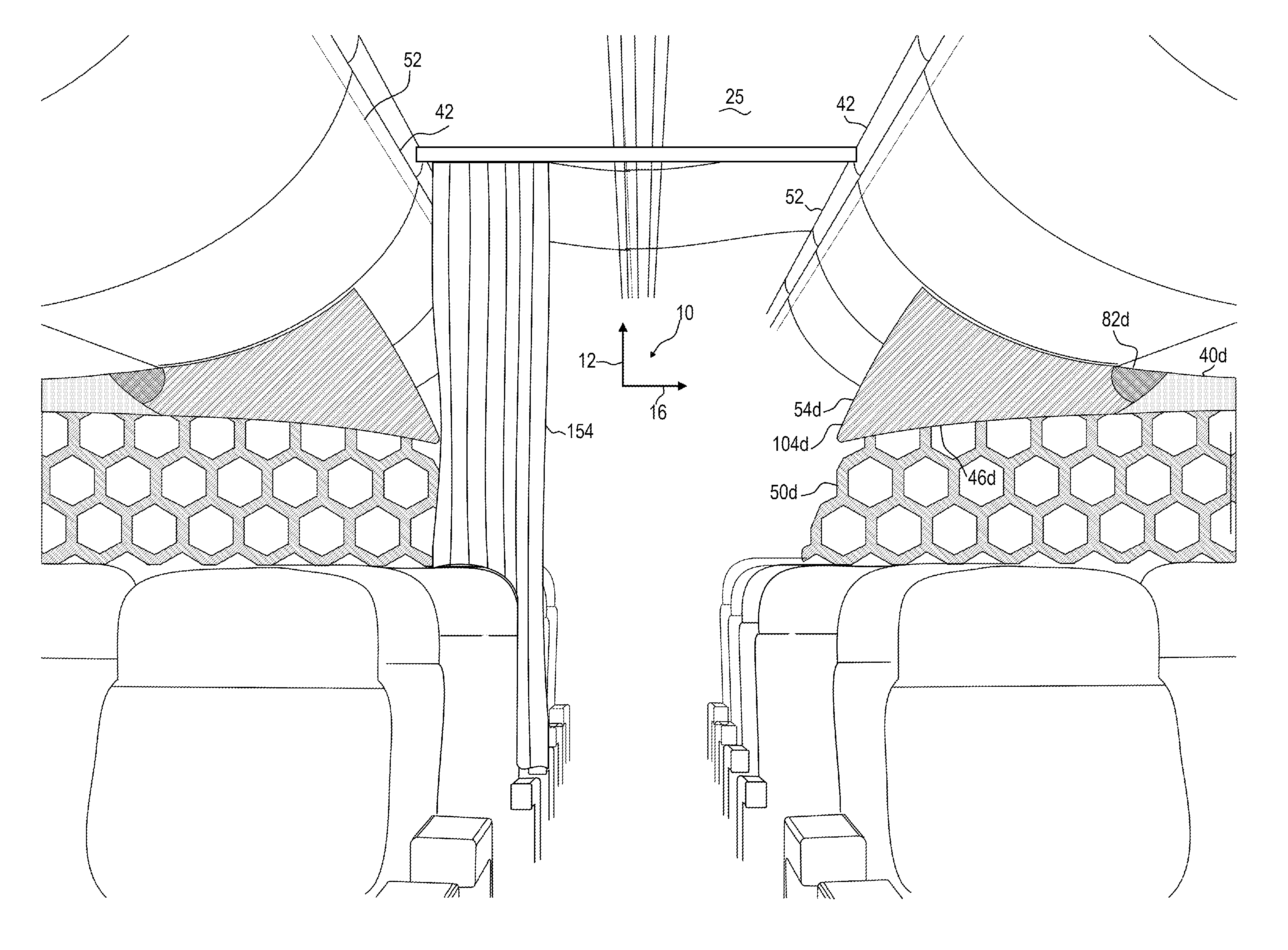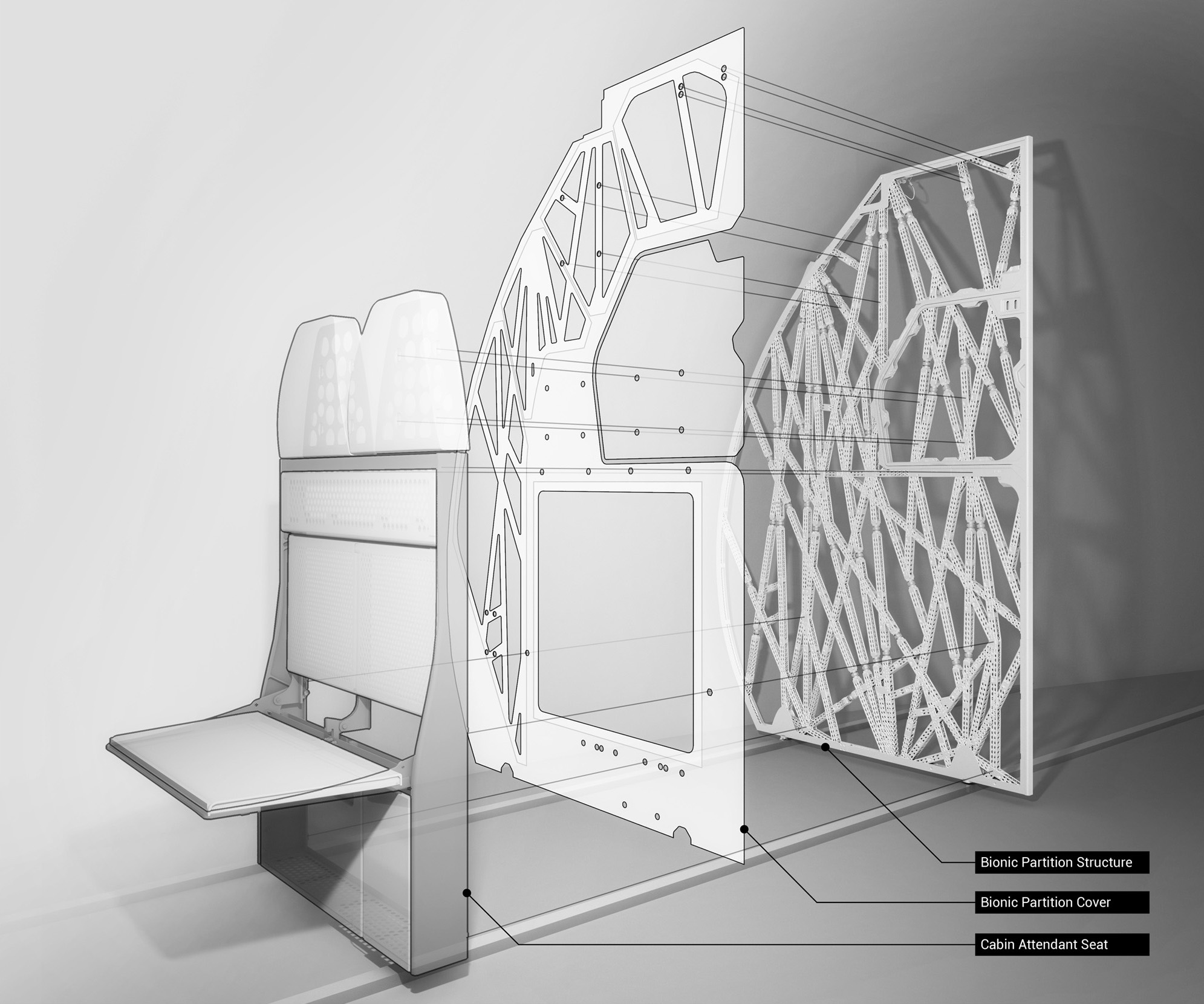Cabin
Divider

Studies have shown that class-based divisions on the plane, manifested physically by the cabin divider, can lead to an increase in air rage.
︎︎︎ Related entries:
Airplane Seats
Armrest
Comfort
PAX
︎ Random Entry
Tags: airplane interior, psychology,
materials, spatial configuration,
sensory (visual, acoustic)
Airplane Seats
Armrest
Comfort
PAX
︎ Random Entry
Tags: airplane interior, psychology,
materials, spatial configuration,
sensory (visual, acoustic)
Design Decisions
Cabin dividers help separate passenger zones in the aircraft cabin between the first, business, and economy classes. Cabin dividers can be curtains, solid thermoplastic barriers, or a combination of galleys and curtains. Cabin dividers’ role as separators between passenger classes came about after the end of World War II when a few US airlines began to offer Economy class seats for the first time. Until then, air travel was by default exclusive to the affluent and the famous.
One of the earliest formalized “sorting” systems of passengers was in the early 1930s [1]. Britain’s Imperial Airways introduced two service classes on its London-Paris route analogous to today’s Business and First class, “so that the famous and influential might have an opportunity to avoid the company of their social inferiors” [2]. From 1939 to 1945, most commercial flying was suspended due to World War II. When it returned after 1945, progressive reform policies in the US incentivized airlines to offer cheaper economy seats. Thus, “In order to physically and psychologically separate the high-yielding full-fare passengers from those in economy, cabin dividers and curtains were employed” [1]. By the 1970s, the three cabin classes that are customary today, first, business, and economy, became standard practice.


Cabin divider patent filings (1991, 2013).
Cabin dividers primarily serve as acoustic, visual, and psychological privacy barriers between the passenger classes. Studies have shown that they assist with lowering noise levels and softening sounds in the cabin, and designers have developed various product lines of sound-absorbing fabric, with an opaque inlay that prevents galley lights from disturbing passengers at night. Sound-absorbing curtains can cut down up to 18 to 53 db depending on frequency of the sound [3].
Additionally, cabin dividers must satisfy a vast amount of functional and material criteria. Like all airplane components, they must be lightweight, occupy a minimal amount of space, and be flame retardant in the event of an accident. Thermoplastic cabin dividers are sometimes integrated with a jump seat, a foldable seat used by flight crew, and can be transformed to accommodate a stretcher in the event of a medical emergency. TSA regulations require that curtains are open during taxi and takeoff, in order to allow flight attendants and passengers a clear view of the whole cabin in the event of an emergency.

Cabin divider patent filings (2014).
Effects on Passengers
A cabin dividers, be it curtains, thermoplastic structures, or galleys, function as acoustic, visual, and psychological privacy barriers.
Acoustically, softening the ambient noise level in the cabin assists with lowering passenger environmental discomfort. There is evidence that constant exposure to loud noises causes an accumulation of cortisol, the stress hormone, in the blood [4], which contributes to one’s inability to control one’s mood, motivation, and fear. Moderating loud or irregular ambient aircraft cabin noise is a useful feature of the cabin divider.
“The sense of hearing - ten times more sensitive than the eye in humans as well - is the most decisive warning and communications organ. This is why it remains open to the environment day and night, and is unable to deny access to sound stimuli in the same way as the eye with its lids closed against impinging light. This is the reason why sounds from the environment are constantly picked up, whether awake or asleep, and trigger massive stimulation of the processing sections of the brain...Noise effects are not only experienced as disturbing, irritating or stressful, but may also be associated with after-effects in terms of health” [4].
In a study conducted in a simulated aircraft, an increase in noise level was shown to have a significant impact on feeling more depressed, grouchy, irritated, anxious and nervous [5]. In addition, noise level not only impacted one’s feelings of acoustic discomfort, but also increased awareness of other non-acoustic aspects impairing comfort, such as swollen feet, headaches, and tiredness [6]. It is important to note that the studies do not imply that the quieter the more comfortable. In a field study on a train, a level of “monotonous” noise was appreciated by passengers for masking other sounds [7].
Cabin dividers also serve as psychological privacy barriers between passenger classes. it remains more ambiguous whether cabin dividers are beneficial or detrimental. “The curtains that hang between service classes also operate as screens, permeable for the flight attendants, but not for the passengers, and shielding groups of passengers from fully realizing their differences as well as their similarities” [8].
It may be that cabin dividers function as symbols of the socioeconomic divide between first class, business, and economy passengers. Studies have shown that this class-based division, manifested physically by the cabin divider, can increase conflict between passengers and incidents of “air rage”. More specifically: “Physical inequality on airplanes—that is, the presence of a first class cabin—is associated with more frequent air rage incidents in economy class. Situational inequality—boarding from the front (requiring walking through the first class cabin) versus the middle of the plane—also significantly increases the odds of air rage in both economy and first class” [9].
It remains to be seen whether cabin dividers help or hurt in exacerbating antisocial behavior arising from situational inequality. One point of note is that the study demonstrated an increase in antisocial behavior in both economy and first class, with “emotional outbursts” more commonly taking place among economy class, and “belligerent behavior” occurring more commonly among the first class. Do the presence of cabin dividers highlight the situational inequality of the class-based sorting of passengers, or do they make the inequality less visible? Or, by making it less visible, does the presence of the cabin divider give first and business classes an air of exclusivity that exacerbates antisocial feelings among all classes?
What-Ifs
What if we reconsidered the way passengers are divided within the aircraft cabin?
Instead of dividing the passengers by economic class, the cabin could be divided by usage types. These usage types might be family lounging, computer work, gaming, and sleeping. Machine learning could be used to help optimize the seating configuration, so that more convivial activities like family lounging and gaming would be adjacent, and quieter activities such as work and sleeping could be paired elsewhere. The aircraft cabin and seating could be redesigned to better suit those activities. Airspace Cabin Vision 2030 video gives several examples of such cabin redesign [10].



Cabin reconfiguration schemes for different usage types, adapted from Airspace Cabin Vision 2030
What if there were cabins for families with small children?
Sounds of crying babies are common sources of acoustical discomfort for many passengers. An area of the cabin can be dedicated to young families traveling with children, with sound-absorbent material integrated into cabin dividers, seating, or flooring. This would provide a noise buffer and a degree of privacy for those families and other passengers.
What if the lower cargo hold deck could contain common spaces for passengers?
Airbus and Safran’s “Lower Deck Pax Experience Modules” proposes a system that uses the cargo hold to include modules for beds, areas for stretching, playground, or meeting spaces. Passengers in the main airplane cabin would have access to this lower deck for these various uses. These modules would fit inside existing aircraft cargo compartments. Multiple passenger modules would be designed in order to fit into the plane interchangeably and the baggage would be stored below or above the module [11, 12].
What if cabin dividers were created out of other materials to optimize weight and reconfigurability?
Installing solid fixed walls into airplanes takes up space and adds weight to the plane, but several sturdy cabin dividers may be necessary to hold jump seats for the crew. Autodesk’s lightweight, 3d-printed latticed structure that acts as a cabin divider may be one solution [13]. The resulting divider is lighter, stronger, and more easily replicated than traditional fixed walls in current planes.

Autodesk’s 3d-printed cabin divider structure
- Budd, Lucy. 2016. “Flights of Indulgence (or How the Very Wealthy Fly): The Aeromobile Patterns and Practices of the Super-Rich.” In Handbook on Wealth and the Super-Rich, 302-321. Edward Elgar Publishing
- Hudson K. and J. Pettifer (1979), Diamonds in the Sky: A Social History of Air Travel, London: Bodley Head.
- Lantal Textiles. n.d. “Ready-to-Install Products: Sound-Absorbing Curtain.” Product Information.
-
Spreng, M. 2004. “Noise Induced Nocturnal Cortisol Secretion and Tolerable Overhead Flights.” Noise & Health 6 (22): 35–47.
- Pennig, Sibylle, Julia Quehl, and Vinzent Rolny. 2012. “Effects of Aircraft Cabin Noise on Passenger Comfort.” Ergonomics 55 (10): 1252–65.
- Mellert, V., Baumann, I., Freese, N., and Weber, R., 2008. “Impact of sound and vibration on health, travel comfort and performance of flight attendants and pilots.” Aerospace Science and Technology, 12, 18–25.
- Khan, S.M., 2003. “Effects of masking sound on train passengers aboard activities and on other interior annoying noises”. Acta Acustica, 89, 711–717.
-
Groening, Stephen. 2013. “Aerial Screens.” History and Technology 29 (3): 284–303.
- DeCelles, Katherine A., and Michael I. Norton. 2016. “Physical and Situational Inequality on Airplanes Predicts Air Rage.” Proceedings of the National Academy of Sciences 113 (20): 5588–91.
- Airbus. 2019. Airspace Cabin Vision 2030. https://www.youtube.com/watch?v=loWML-pIsaU.
- Airbus. 2019. “Airbus and Safran Win Crystal Cabin Award with Lower Deck Pax Experience Modules.” Press Release. April, 2019.
- Walton, John. “Airbus-Safran Lower Deck Pax Experience Modules in Firm Development.” Runway Girl Network, April 18, 2019.
- “Generative Design at Airbus | Customer Stories | Autodesk.” n.d. Accessed November 3, 2019.